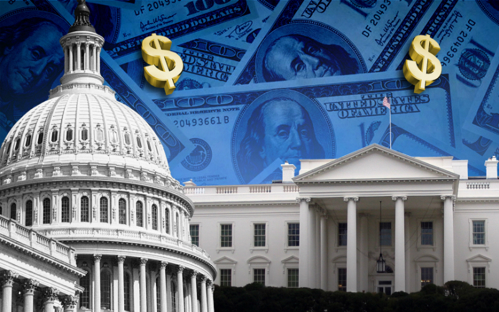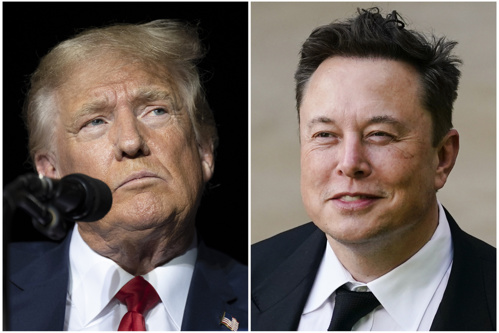The economic outlook, released three days before Donald Trump’s inauguration, was perhaps overlooked by other historic events in the news cycle.
But the bad news shouldn’t be ignored for long, warns economist Dave Brat, the former congressman who is now senior vice president for Business Relations at Liberty University.
The current national debt is slightly more than $36 trillion and growing daily.
 The U.S. is running in the neighborhood of a $2 trillion deficit annually. That equates to an additional $20 trillion in debt over the next 10 years.
The U.S. is running in the neighborhood of a $2 trillion deficit annually. That equates to an additional $20 trillion in debt over the next 10 years.
For many, trying to process the numbers leads is futile, but all Americans understand their pocketbooks, and the cost of this mismanagement will show up in their investments, Brat told the Washington Watch program.
“Sooner or later reality will hit, and that’s all tied to the stock market bubble,” Brat said.
“In the 10 Commandments, it says do not steal. We’re stealing from our own children. That’s how bad it is, but you never hear the moral side of this thing," he observed.
The CBO forecast reflects the economy through Dec. 4. It does not include the 2025 Trump administration efforts of Elon Musk and the Department of Government Efficiency to stop government fraud and excessive spending through the United States Agency for International Development (USAID) and more.
 The CBO predicts another $1.9 trillion in debt for 2025 and another $24 trillion in debt over the next 10 years.
The CBO predicts another $1.9 trillion in debt for 2025 and another $24 trillion in debt over the next 10 years.
“I'm just using loose numbers just so I don't lose track. The numbers don't matter as much as understanding them,” Brat said.
The inflation the U.S. is currently experiencing occurred because the government printed $9 trillion in new money, a hidden tax of 25%, Brat said.
“That’s a tax on the value of your dollar over the past five years, so a 25% loss of purchasing power, and the deficits are going to government spending," he said. "They’re counting government spending as part of economic growth.
“That’s like you borrowing $2 trillion from your rich uncle then telling your neighbors, ‘My firm is growing by $2 trillion because you borrowed from your rich uncle. That’s not growth. You didn’t grow anything. You just went into debt,” Brat said.
How productivity figures in
The other key component in the picture is economic productivity.
A nation’s productivity is typically measured by comparing outputs and inputs used in its production.
The output is usually measured as the gross domestic product (GDP), which represents the total value of goods and services produced in the country.
Inputs are measured by the number of hours worked, which accounts for differences achieved through full-time vs. part-time work, holidays, vacations and strikes.
This measure helps determine how efficiently a country uses its resources to produce economic output.

Economic growth mirrors productivity, Brat said.
“Our productivity has been going down in the U.S. for the past 70 years. Now it’s at 2%. You look at those CBO reports, and we’re going to grow at 2% for the next 10 years as well,” he said.
Too many economic and political leaders either don’t understand or are ignoring the big picture, Brat said.
 “There’s a bunch of conservative, libertarian-minded economists saying, ‘We’re going to grow our way out of this. You get these cheerleader types, but that’s not true. I wish it were, I would say so,” Brat said.
“There’s a bunch of conservative, libertarian-minded economists saying, ‘We’re going to grow our way out of this. You get these cheerleader types, but that’s not true. I wish it were, I would say so,” Brat said.
Instead, it’s a bleak picture.
“The CBO folks are putting out these numbers with productivity going down from 1.9% to 1.5% over the next 10 years. We’re in debt up to our eyeballs.”
Congress is considering spending cuts of $300 billion over 10 years with welfare and healthcare reforms part of the discussion.
“That’s like a teaspoon,” Brat said of the cutting proposal.
The silver lining
The Biden administration chose deficit growth to keep the economy from going over the cliff, Brat said.
“But sooner or later reality will hit," he said. "That’s all tied to the stock market bubble as well.”
The hope, Brat says, is that he senses an awakening from Americans.
“There is a turnaround in this country spiritually and psychologically," he predicted. "There’s positive energy again. We’re not scared. Markets will be less fearful of doing the right things instead of all these crazy initiatives. That’s the good news. Kids are waking up to this stuff, so I think there’s a glimmer of hope there.”







